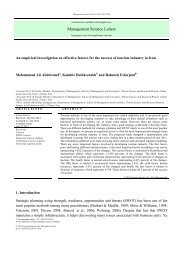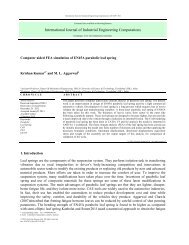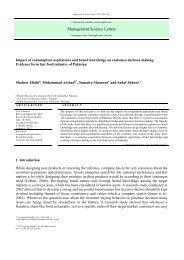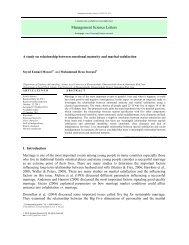334 F ≤ j+ A(1 − X ) ∀ i, j; (12.6) ij ij F ≥ j− A(1 − X ) ∀ i, j; (12.7) ij ij F ≤ AX . ∀ i, j; (12.8) ij ij This section can be shown for each of the two possible cases that can arise. 1. Xij . Qij-1 = Qij-1. ∀ i, j; Such a situation arises when Xij = 1 so, constraints (12.3) and (12.4) implies Rij ≤ Qij-1 and Rij ≥ Qij-1 and ensures that Rij = Qij-1. 2. Xij .Qij-1 = 0. Such a situation arises under one of the following three sub-cases: (a) Xij = 1 and Qij-1 = 0. ∀ i, j; (b) Xij = 0 and Qij-1 > 0. ∀ i, j; (c) Xij = 0 and Qij-1 = 0. ∀ i, j; In all of the three sub-cases given above, Rij takes the value of 0, because in these cases, constraint (12.5) implies Rij ≤ 0 and ensures that Rij = 0. Because Rij has not a strictly positive cost coefficient, the minimizing objective function doesn’t ensures that Rij = 0. Thus, constraint (12.5) should be added to the mathematical model. The performance of constraints (12.6) - (12.8) is similar to constraints’ (12.3) and (12.5). Appendix D. The Proof of proposition 4 Consider the following two sections: (i) In term Si = min ⎡ j+ A(1 − Xij) ⎤ j ⎣ ⎦ , we find the first position of process for job i. In constraint (13.2), when for the first position, for example position j, Xij = 1, then Bij takes value 1 and since for the following positions which are larger than j, Bijs take value 1, then the summation of Bijs implies the number of positions where job i is work-in-process. Thus Si returns the first position number in constraint (13.3). (ii) The non-linear constraint (13.2) can be liberalized by the following transformation 1 . B ij − X ij = Gij , under the following sets of constraints: Gij ≤ Bij−1 + A(1 − Xij ) ∀ i, j; (13.4) Gij ≥ Bij−1 − A(1 − Xij ) ∀ i, j; (13.5) G ≤ AX . ∀ i, j; (13.6) ij ij Thus, constraints (13.1) - (13.6) should be added to the mathematical model. The performance of constraints (13.4) - (13.6) is similar to constraints’ (12.3) - (12.5). References Bector, C.R., Gupta, Y.P., & Gupta, M.C. (1988). Determination of an optimal common due date and optimal sequence in a single machine jobshop. International Journal of Production Research 26, 613–628. Bülbül, K., Kaminsky, P., & Yano, C. (2007). Preemption in single machine earliness/tardiness scheduling. Journal of Scheduling 10, 271-292.
M. Kazemi et al. / International Journal of Industrial Engineering Computations 3 (2012) Davis, J.S., Kanet, J.J. (1993). Single-machine scheduling with early and tardy completion costs. Naval Research Logistics 40, 85-101. Esteve, B., Aubijoux, C., Chartier, A., & T’kindt, V. (2006). A recovering beam search algorithm for the single machine Just-in-Time scheduling problem. European Journal of Operational Research 127, 798-813. Garey, M.R., Tarjan, R.E., & Wilfong, G.T. (1988). One-processor scheduling with symmetric earliness and tardiness penalties. Mathematics of Operations Research 13, 330-348. Gupta, J.N.D., & Chantaravarapan S. (2008). Single machine group scheduling with family setups to minimize total tardiness. International Journal of Production Research 46, 1707–1722. Hendel, Y., Runge, N., & Sourd, F. (2009). The one-machine just-in-time scheduling problem with preemption. Discrete Optimization 6, 10-22. Hendel, Y., & Sourd, F. (2005). The single machine just-in-time scheduling problem with preemptions. In: MISTA 2005: proceedings of the 2nd multidisciplinary international conference on scheduling: theory and applications. p. 140–8. Hendel, Y., & Sourd, F. (2006). Efficient neighborhood search for the one-machine earliness/tardiness scheduling problem. European Journal of Operational Research 173, 108-119. Hepdogan, S., Moraga, R., DePuy, G.W., & Whitehouse G.E. (2009). A meta-RaPS for the early/tardy single machine scheduling problem. International Journal of Production Research 47, 1717–1732. Hoogeveen, J.A., & Van de Velde, S.L. (1996). A branch-and-bound algorithm for single-machine earliness/tardiness scheduling with idle time. INFORMS Journal on Computing 8, 402-412. Khorshidian, H., Javadian, N., Zandieh, M., Rezaeian, J., & Rahmani, K. (2011). A genetic algorithm for JIT single machine scheduling with preemption and machine idle time. Expert Systems with Applications 38, 7911-7918. Liao, C.-J., & Cheng, C.-C. (2007). A variable neighborhood search for minimizing single machine weighted earliness and tardiness with common due date. Computers and Industrial Engineering 52, 404-413. Luo, X., Chu, Ch., & Wang, Ch. (2006). Some dominance properties for single-machine tardiness problem with sequence-dependent setup times. International Journal of Production Research 44, 3367–3378. M’Hallah, R. (2007). Minimizing total earliness and tardiness on a single machine using a hybrid heuristic. Computers & Operations Research 34, 3126-3142. Nandkeolyar, U., Ahmed, M., & Sundararaghavan, P. (1993). Dynamic single-machine-weighted absolute deviation problem: predictive heuristics and evaluation. International Journal of Production Research 31(6), 1453–1466. Runge, N., & Sourd, F. (2009). A new model for the preemptive earliness–tardiness scheduling problem. Computers & Operation Research, 36, 2242-2249. Seidmann, A., Panwalkar, S.S., & Smith, M.L. (1981). Optimal assignment of due dates for a single processor scheduling problem. International Journal of Production Research 19, 393–399. Shirazi, B., Fazlollahtabar, H., & Sahebjamnia, N. (2010). Minimizing arbitrary earliness/tardiness penalties with common due date in single-machine scheduling problem using a Tabu-Geno- Simulated Annealing. Materials and Manufacturing Processes 25, 515–525. Sourd, F., & Kedad-Sidhoum, S. (2003). The one-machine scheduling with earliness and tardiness penalties. Journal of Scheduling 6, 533-549. Sourd, F., & Kedad-Sidhoum, S. (2008). A faster branch-and-bound algorithm for the earliness_tardiness scheduling problem. Journal of Scheduling 11, 49-58. Szwarc, W., & Mukhopadhyay, S.K. (1955). Optimal timing schedules in earliness/tardiness single machine sequencing. Naval Research Logistics 42, 1109-1114. Tavakkoli-Moghaddam, R., Moslehi, G., Vasei, M., & Azaron, A. (2005). Optimal scheduling for a single machine to minimize the sum of maximum earliness and tardiness considering idle insert. Applied Mathematics and Computation 167, 1430-1450. 335








